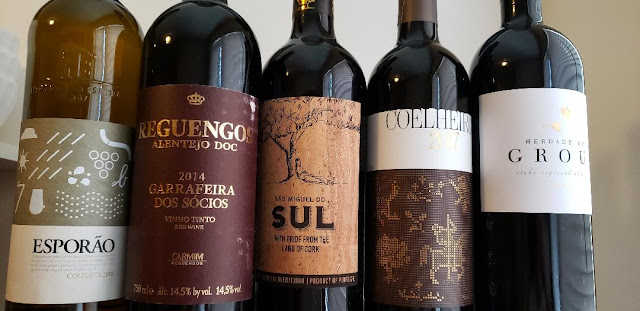I’m thankful and privileged to be healthy and safe during these pandemic times. But, like many millions of people, my travel plans for this year have evaporated.
For my five-year-old daughter’s birthday this spring, I was thrilled to bring my family to Portugal. It is a country whose culture, wine, waves, food and natural bounty fascinate me to no end. When I’m there, I often think, more than any other place I’ve visited: I should have been born here. While that trip is dashed, I can’t wait to get back when it’s safe to do so.
When I visited the region of Alentejo three years ago, I found an overwhelming amount of diverse and high-quality wines and producers. It was such a treat to dig deep into the region’s tradition of wines fermented in amphora, explore the history and diversity of the region’s adopted red grape Alicante Bouschet, and I was impressed to learn about the exciting white wines produced there as well.
As an outdoors, nature and wildlife enthusiast, it was sometimes hard to think about wine while I was traveling through Alentejo — there was just so many rolling hills, forests, fields, and natural beauty going by outside my window. With relatively low population density, large amounts of uncultivated land, and ever presence of the famous cork forests, the region offers a lot of unspoiled natural beauty and thriving wildlife. Among the group I traveled with was Wines of Alentejo’s U.S. director Tiago Caravana, who, in addition to his wine career, is an incredible wildlife photographer, and was always on point with my random questions about the region’s diverse mammals and birds of prey.
So, I hopped at the chance to attend a webinar with Tiago and others in the region’s trade group this summer. We tasted what I consider to be some really solid examples of what the region can produce, and we spent a lot of time discussing the sustainability efforts of the regional winegrowing commission. Lots of Alentejo producers have been taking sustainable vineyard and winery practices serious for many years, but in 2014, the regional winegrowing commission created a voluntary program called Wines of Alentejo Sustainability Program.
This program is designed to improve environmental, social and economic welfare in the region, specifically focusing on issues like water control, pest management, energy conservation, and packaging. Several of the wineries represented in the tasting focused on their attempts at improving sustainability by using sheep to reduce cover crops, utilizing bat boxes to fight pesky insects, increasing use of solar power, reducing bottle weight, etc.
But the proof is in the bottle, and these wines offer a good window into Alentejo’s ancient and thriving wine culture. These wines were received as trade samples and tasted sighted.
2018 Herdade do Esporão “Colheita” Branco - Portugal, Alentejano, Alentejo
SRP: $16
Medium yellow color. Generous aromas of nectarine, peaches, cantaloupe, with honeycomb, hay, nougat and floral perfume. Creamy texture on the palate with crisp acidity, deep but balanced with lovely yellow plums, apricot and orange peel. Juicy, deep but bright with notes of sea salt, chalk, toasted almond, honey, hay and candle wax. Expressive, complex, everything is lined up wonderfully in this crazy value of a white wine. Antao Vas, Viosinho, Alvarinho and other white grapes, fermented partially in concrete, aged on the lees for four months. (90 points)
2018 Casa Agricola Alexandre Relvas “Sao Miguel do Sul” - Portugal, Alentejano, Alentejo
SRP: $12
Medium purple color. Aromas of jammy raspberry, blackberries, with vanilla, grilled herbs, pepper and cola. Full-bodied, velvety tannins, medium/low acidity. A soft, accessible, chewy feel with sweet plum and raspberry jams, along with some cocoa, cola and tobacco. Fun, easy-drinking stuff but some freshness and complexity as well. Aragonez, Alicante Bouschet, Trincadeira and Cabernet Sauvignon. (86 points)
2018 Herdade dos Grous Tinto - Portugal, Alentejano, Vinho Regional Alentejano
SRP: $19
Light purple color. On the nose, with jammy raspberries, strawberry, with smoky earth, mint, charcoal, rose petals. Bold but surprisingly fresh on the palate with velvety tannins and plenty of raspberry, black cherry and plum jam fruit. Notes of spicy tobacco, earth, mint, cocoa powder make this a dynamic wine for the price. Fresh but complex, delightfully grill-out friendly. 35% Alicante Bouschet, 35% Aragonez with Touriga Nacional and Syrah, aged nine months in French oak. (88 points)
2017 Herdade dos Coelheiros “Coelheiros” - Portugal, Alentejano, Alentejo
SRP: $20
Deep purple color. Rich, suave aromas of black currants, black cherries, roasted plums, with smoky earth, cocoa, ginger snaps and pepper. Full-bodied with velvety tannins, medium acidity keeps it lively. Suave blackberry and roasted fig fruit mixes with notes of pencil lead, cocoa, coffee, vanilla. Fresh despite the generosity of fruit. Could age but great now for grilling. Real good stuff for Zinfandel fans looking to branch out. Aragonez and Alicante Bouschet, aged 12 months in French oak. (88 points)
2014 Carmim Reguengos “Garrafeira dos Sócios” - Portugal, Alentejano, Alentejo, Reguengos
SRP: $48
Medium purple color. Complex aromas of tart cherries and blackberries, with deep green and black olive tones, tilled earth, anise and coffee grounds. Full-bodied, with dusty tannins, medium acidity, a structured but lively feel. Cherries and blackberries mix well with complex notes of anise, leather, charcoal, dusty earth, mineral and rocky elements. This is in a great place right now, and just goes to show how well Alentejo wines can age. Alicante Bouschet with 20% Touriga Nacional and 15% Tinta Caiada, aged in French and American oak for 14 months. (90 points)

No comments:
Post a Comment